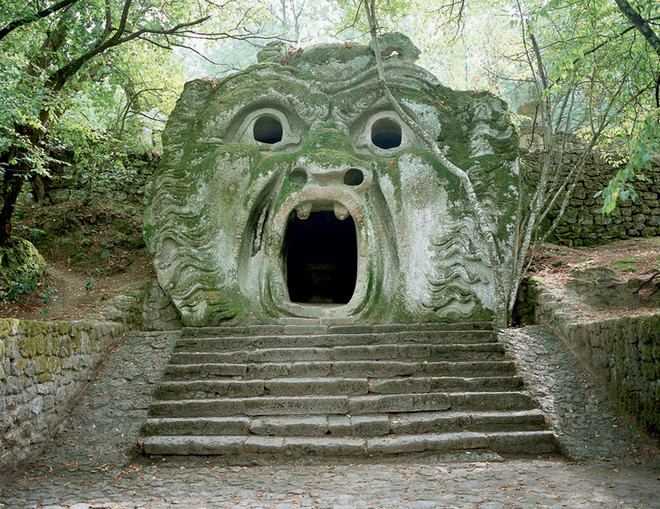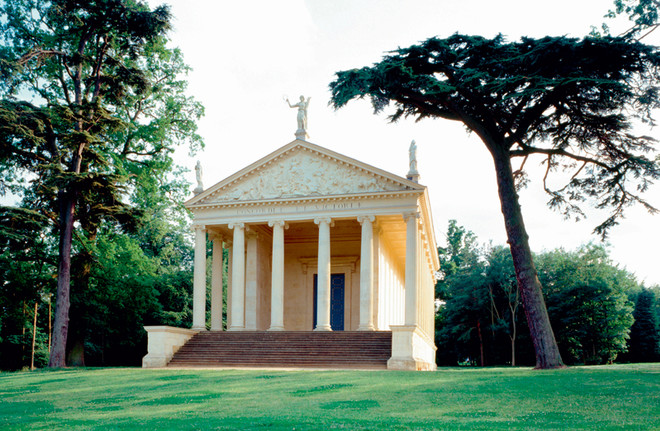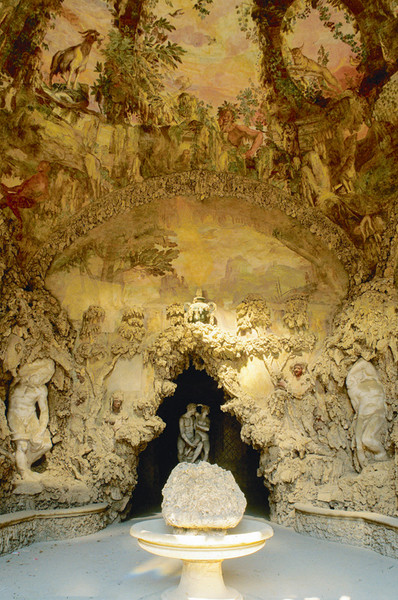Park folies (from the French folies —madness) swept the gardens of Europe in the 18th century, after the fashion for came from England, an organic part of which were various pavilions. Each landowner tried to outdo his neighbor, erecting endless gazebos, pavilions, Chinese houses on his lands, designed to decorate the landscape, give strollers rest, surprise and entertain. Park of the Monsters of Bomarzo Parks and GardensLandscape designers had a lot to work withTake an example: everyone has heard of the Bomarzo Park of Monsters, laid out in the 16th century by Duke Pier Francesco (Vicino) Orsini. Among other things, there was even a cave in the form of the open mouth of Orcus, the lord of the underworld. On his lips is carved a slightly modified quote from Dante: "Let all ye who enter here cease to ponder." Lavish dinners were served inside, after which the most distinguished guests were carried into the falling house in a sleeping state (one can imagine what their awakening was like). Two centuries later, there were inventors who, if not surpassed the Duke, then gave him worthy competition. For example, the eccentric and even somewhat scandalous Sir Francis Dashwood, in his West Wycombe estate, in addition to rotundas, temples and music pavilions, dug a cave at the base of the hill, and erected a church on the hill. In it, Sir arranged the "Hellfire Club", where he regularly got drunk with his friends and organized orgies that went down in history. However, base entertainment did not interfere with the sublime ones. In the pavilion, repeating the shape of Diogenes' barrel, one had to conduct philosophical conversations, wandering through the labyrinth - looking for the difficult path to virtue, and entering the water grotto - saying goodbye to this world for the sake of the other world. In a word, what today seems to us a conglomerate of bushes, flower beds, fountains, gazebos and shady alleys, for the creators of garden ensembles of past centuries was a collection of carefully thought-out emblems and symbols.
Parks and GardensLandscape designers had a lot to work withTake an example: everyone has heard of the Bomarzo Park of Monsters, laid out in the 16th century by Duke Pier Francesco (Vicino) Orsini. Among other things, there was even a cave in the form of the open mouth of Orcus, the lord of the underworld. On his lips is carved a slightly modified quote from Dante: "Let all ye who enter here cease to ponder." Lavish dinners were served inside, after which the most distinguished guests were carried into the falling house in a sleeping state (one can imagine what their awakening was like). Two centuries later, there were inventors who, if not surpassed the Duke, then gave him worthy competition. For example, the eccentric and even somewhat scandalous Sir Francis Dashwood, in his West Wycombe estate, in addition to rotundas, temples and music pavilions, dug a cave at the base of the hill, and erected a church on the hill. In it, Sir arranged the "Hellfire Club", where he regularly got drunk with his friends and organized orgies that went down in history. However, base entertainment did not interfere with the sublime ones. In the pavilion, repeating the shape of Diogenes' barrel, one had to conduct philosophical conversations, wandering through the labyrinth - looking for the difficult path to virtue, and entering the water grotto - saying goodbye to this world for the sake of the other world. In a word, what today seems to us a conglomerate of bushes, flower beds, fountains, gazebos and shady alleys, for the creators of garden ensembles of past centuries was a collection of carefully thought-out emblems and symbols.
Temples
 Greek Temple (1747–1749) in the English ParkStowe. Pavilions in the form of classical temples appeared in gardens as early as the 17th century. The architects of that time literally transferred into reality the buildings from the canvases of the classicist artists Poussin and Lorrain. But the real discovery of antiquity occurred in the next century, when the Grand Tour became an obligatory part of the education of a young gentleman. The English lived in Rome for a long time, examined the ruins of Greece, and upon returning home, reproduced monuments of antiquity in their country estates. The bible of architects was the book "Antiquities of Athens", published in 1762, which depicted several small temples, the main advantage of which was that, unlike the Parthenon, they easily fit into the English landscape. Sir Francis Dashwood, already mentioned, had a dozen ornamental temples in West Wycombe: to Venus, the Winds, Apollo, Daphne, and another temple, Kitty Lodge, dedicated to a pretty peasant girl. The Temples of Love, where lovers met, and Friendship, where friendly drinking parties were held, became common places for park construction.
Greek Temple (1747–1749) in the English ParkStowe. Pavilions in the form of classical temples appeared in gardens as early as the 17th century. The architects of that time literally transferred into reality the buildings from the canvases of the classicist artists Poussin and Lorrain. But the real discovery of antiquity occurred in the next century, when the Grand Tour became an obligatory part of the education of a young gentleman. The English lived in Rome for a long time, examined the ruins of Greece, and upon returning home, reproduced monuments of antiquity in their country estates. The bible of architects was the book "Antiquities of Athens", published in 1762, which depicted several small temples, the main advantage of which was that, unlike the Parthenon, they easily fit into the English landscape. Sir Francis Dashwood, already mentioned, had a dozen ornamental temples in West Wycombe: to Venus, the Winds, Apollo, Daphne, and another temple, Kitty Lodge, dedicated to a pretty peasant girl. The Temples of Love, where lovers met, and Friendship, where friendly drinking parties were held, became common places for park construction.
Grotto
 The Grotto (1592) by Bernardo Buontalenti and todaydecorates the Boboli Gardens in Florence. The architect Leon Battista Alberti (1404-1472) recommended building cool grottoes (from the Italian grotta - "cave") in gardens. During the Mannerist era, grottoes were often used as baths or places of solitude where one could admire collections of minerals (often fake). The interior of a grotto could imitate a dragon's lair or an underwater cave, the walls of which were decorated with shells and corals. The interiors were decorated with sculptures of mythical creatures that, according to legend, lived in the water, and were often equipped with hydraulic machines that made these statues move. Open grottoes of Italy in European countries with a colder climate turned into garden pavilions. Such a grotto, baroque on the outside and resembling an underwater cave on the inside, can be seen in the Moscow estate of Kuskovo. A fountain was installed on its roof, streams of water flowed down the walls, and the ladies and gentlemen inside felt like the rightful rulers of the underwater kingdom.
The Grotto (1592) by Bernardo Buontalenti and todaydecorates the Boboli Gardens in Florence. The architect Leon Battista Alberti (1404-1472) recommended building cool grottoes (from the Italian grotta - "cave") in gardens. During the Mannerist era, grottoes were often used as baths or places of solitude where one could admire collections of minerals (often fake). The interior of a grotto could imitate a dragon's lair or an underwater cave, the walls of which were decorated with shells and corals. The interiors were decorated with sculptures of mythical creatures that, according to legend, lived in the water, and were often equipped with hydraulic machines that made these statues move. Open grottoes of Italy in European countries with a colder climate turned into garden pavilions. Such a grotto, baroque on the outside and resembling an underwater cave on the inside, can be seen in the Moscow estate of Kuskovo. A fountain was installed on its roof, streams of water flowed down the walls, and the ladies and gentlemen inside felt like the rightful rulers of the underwater kingdom.









